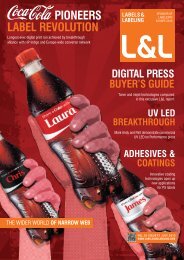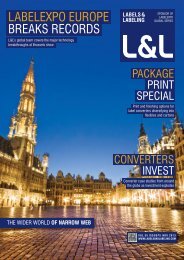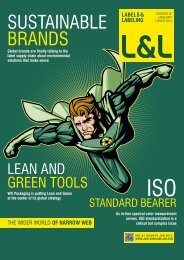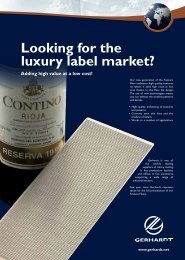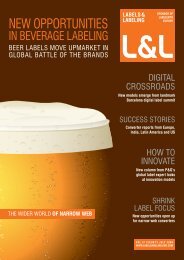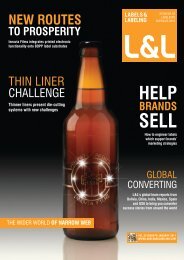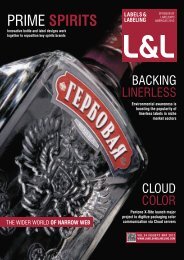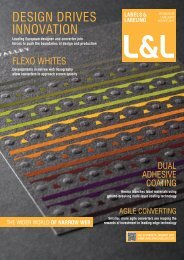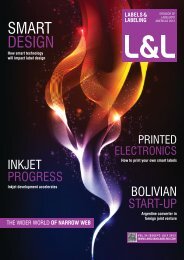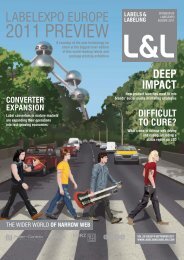THE DATA FRONT
Download as PDF - Labels & Labeling
Download as PDF - Labels & Labeling
- No tags were found...
Create successful ePaper yourself
Turn your PDF publications into a flip-book with our unique Google optimized e-Paper software.
90 | l&l<br />
Coating strategies<br />
HP Indigo’s digital label press series requires specially coated substrates to key inks. Andy Thomas<br />
looks at those requirements and the choice between in-house coating and pre-coated substrates<br />
Achieving the best results on the HP Indigo ws4000 and<br />
WS6000 press series is a factor of the ability of the special HP<br />
Indigo ElectroInk technology to key to the printing stock – and<br />
this requires a special topcoating.<br />
The special formulation and delivery of ElectroInk will not<br />
give acceptable results on untreated stocks, or on materials<br />
treated with conventional print surface primers. Based on<br />
nano-particles of color suspended in oil, ElectroInk technology<br />
delivers a thin ink layer to the print substrate, which depends<br />
on a surface pre-treatment to achieve good ink key.<br />
In a recent presentation at the Digital Label Summit in<br />
Barcelona, speakers from Avery Dennison and ExxonMobil<br />
presented data demonstrating how critical is a properly<br />
engineered coating for ElectroInk to key properly to film and<br />
paper substrates.<br />
For coatings to be officially certified by HP Indigo for use with<br />
its ElectroInk, they must meet strict parameters established<br />
by the company. Certification of high-value self-adhesive<br />
laminates has proven to be a helpful driver of self-confidence<br />
for label printers new to the technology.<br />
Comments Gerard Geurts, industrial media manager<br />
worldwide for HP Indigo: 'Our imaging process is different, so<br />
we want to assure our customers that the materials we certify<br />
will consistently perform on our machines. HP Indigo certified<br />
materials meet all our lengthy test parameters, not just for ink<br />
adhesion, but also for machine wear-and-tear. Our ‘stress test’<br />
enables us to evaluate the way in which a printing substrate<br />
affects the press itself and all the related print consumables –<br />
ink, plates and blanket.'<br />
Given the increased availability of specialty coated<br />
laminates, when should label converters coat their<br />
own materials in-house?<br />
An interesting case study is provided<br />
by Eccoprint in Hirtshals, Denmark,<br />
a third-generation family-owned<br />
narrow web converting business, which orders standard stocks<br />
for its UV letterpress Nilpeter press alongside specially coated<br />
materials for the company’s ws4050.<br />
Comments Eccoprint managing director Jan Viberg Elleriis,<br />
'With our Indigo press, we can really respond fast to our<br />
customers' urgent needs for short-run self-adhesive labels.<br />
Sometimes we get the files in during the morning, and deliver<br />
the printed labels in the afternoon.'<br />
Elleriis is a regular customer for the Fasson Digital Indigo<br />
range: 'The quality of the topcoating is excellent, and we get<br />
first-class print results'. The rolls are supplied press-ready<br />
– there is no need for any additional in-house processing<br />
or priming – so material waste and press downtime are<br />
minimized. But there are times when a particular facestock is<br />
not available in the Digital Indigo range, or when his customer<br />
needs order turnaround in a matter of a few hours.<br />
In situations like this, Elleriis topcoats material himself on<br />
the finishing station of the Indigo press, using the broad<br />
inventory of standard Fasson labelstocks he keeps for his<br />
non-digital work. While this gives Eccoprint the capability of<br />
turning round an order quickly, it can be costly. Adding an extra<br />
offline process to the production of the finished labels ties up<br />
equipment, labor, time, and energy – costs which all contribute<br />
to the final price of a label – and creates more set-up and<br />
rewind material waste. 'It is obviously more cost-effective to use<br />
ready-coated labelstocks for short-run work -- but sometimes I<br />
have to take the other route!' says Elleriis.<br />
An alternative to using the finishing station of the Indigo<br />
press to topcoat is to purchase a small off-line coater – again,<br />
additional investment, and often additional material waste.<br />
‘Coating quality may not be as consistent as<br />
a precisely-calibrated industrial coater,<br />
which may adversely affect print<br />
quality,’ says Fasson.<br />
HP Indigo's WS6000 digital press<br />
Labels&Labeling



